
Martin Middlebrook is an English military historian and author.

No. 578 Squadron RAF was a heavy bomber squadron of the Royal Air Force during the Second World War.

Operation Bellicose was an attack by Avro Lancaster bombers of the Royal Air Force on a German radar factory housed in the former Zeppelin Works at Friedrichshafen and the Italian naval base at La Spezia. It was the first shuttle bombing raid in the Second World War and the second use of a Master Bomber. In early June 1943, a Central Interpretation Unit photo interpreter identified a stack of ribbed baskets at the Zeppelin Works. After Winston Churchill viewed the photos at RAF Medmenham on 14 June, No. 5 Group RAF received the surprise orders on 16 June to attack Friedrichshafen during the next full moon.
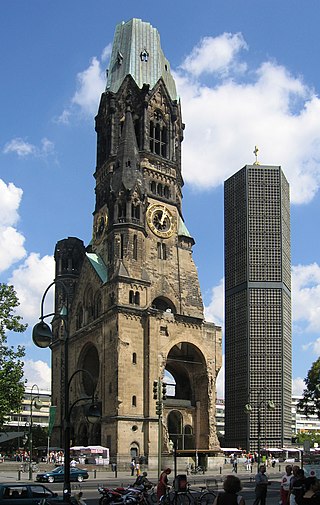
The Battle of Berlin was a bombing campaign against Berlin by RAF Bomber Command along with raids on other German cities to keep German defences dispersed. Air Chief Marshal Sir Arthur Harris, Air Officer Commanding-in-Chief (AOC-in-C) Bomber Command, believed that "We can wreck Berlin from end to end if the USAAF come in with us. It will cost us between 400 and 500 aircraft. It will cost Germany the war".
Wing Commander Bransome Arthur "Branse" Burbridge, was a Royal Air Force (RAF) night fighter pilot and flying ace—a pilot credited with at least five enemy aircraft destroyed—who holds the Allied record of 21 aerial victories achieved at night during the Second World War.

Operation Hydra was an attack by RAF Bomber Command on a German scientific research centre at Peenemünde on the night of 17/18 August 1943. Group Captain John Searby, commanding officer of No. 83 Squadron RAF, commanded the operation, the first time that Bomber Command used a master bomber to direct the attack of the main force. Hydra began the Crossbow campaign against the German V-weapon programme. The British lost 215 aircrew and 40 bombers, and killed several hundred enslaved workers in the nearby Trassenheide forced labour camp. The Luftwaffe lost twelve night-fighters and about 170 German civilians were killed, including two V-2 rocket scientists. Prototype V-2 rocket launches were delayed for about two months, testing and production was dispersed and the morale of the German survivors was severely affected. However, the impact of this British operation on German V-weapon production was apparently lumped together with subsequent Allied attacks on Peenemünde as "not effective" in the 1945 "Summary Report" of the United States Strategic Bombing Survey. The Germans had already started to disperse the manufacturing of the V-2 in 1942, for example to Raderach near Friedrichshafen on Lake Constance.

Wolfgang Falck was a World War II German Luftwaffe pilot and wing commander and one of the key organisers of the German night fighter defences. As a fighter ace, he claimed eight enemy aircraft shot down in 90 combat missions.
Nachtjagdgeschwader 1 (NJG 1) was a German Luftwaffe night fighter-wing of World War II. NJG 1 was formed on 22 June 1940 and comprised four Gruppen (groups). NJG 1 was created as an air defence unit for the Defence of the Reich campaign; an aerial war waged by the Luftwaffe against the bombing of the German Reich by RAF Bomber Command and the United States Air Force. In 1941 airborne radar was introduced with radar operators, and standardised in 1942 and 1943. Consequently, a large number of German night fighter aces existed within NJG 1.
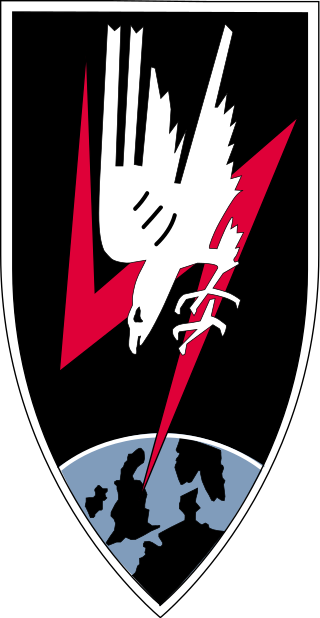
Nachtjagdgeschwader 3 was a Luftwaffe night fighter-wing of World War II. NJG 3 was formed on 29 September 1941 in Stade from Stab./Zerstörergeschwader 26.
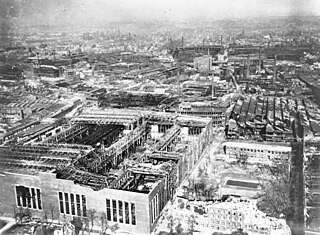
The Battle of the Ruhr was a strategic bombing campaign against the Ruhr Area in Nazi Germany carried out by RAF Bomber Command during the Second World War. The Ruhr was the main centre of German heavy industry with coke plants, steelworks, armaments factories and ten synthetic oil plants. The British attacked 26 targets identified in the Combined Bomber Offensive. Targets included the Krupp armament works (Essen), the Nordstern synthetic oil plant at Gelsenkirchen and the Rheinmetal–Borsig plant in Düsseldorf, which was evacuated during the battle. The battle included cities such as Cologne not in the Ruhr proper but which were in the larger Rhine-Ruhr region and considered part of the Ruhr industrial complex. Some targets were not sites of heavy industry but part of the production and movement of materiel.
The Wilhelmshaven World War II bombings by the Allies of World War II destroyed targets at Wilhelmshaven in Germany. From spring 1943 until November 1943 slave labourers of the SS-Baubrigade II from the Neuengamme concentration camp were transferred to Wilhelmshaven to clear up after air raids.
Nachtjagdgeschwader 5 was a Luftwaffe night fighter-wing of World War II. NJG 5 was formed on 30 September 1942 in Döberitz.
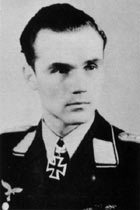
Gerhard Ferdinand Otto Raht was a German Luftwaffe military aviator during World War II, a night fighter ace credited with 58 aerial victories claimed in 171 combat missions making him the tenth most successful night fighter pilot in the history of aerial warfare. All of his victories were claimed over the Western Front in Defense of the Reich missions against the Royal Air Force's (RAF) Bomber Command.
Werner Baake was a night fighter pilot fighter ace and recipient of the Knight's Cross of the Iron Cross who served in the Nazi German Luftwaffe during World War II. The Knight's Cross of the Iron Cross was awarded to recognize extreme battlefield bravery or successful military leadership. Baake claimed 41 nocturnal aerial victories in 195 combat missions. He was the 36th most successful night fighter ace of World War II, and of aerial warfare. Baake's total surpassed that of all Allied night fighter pilots; Branse Burbridge being the highest.

Paul Gildner was a German Luftwaffe military aviator during World War II, a night fighter ace credited with 44 aerial victories, including two by day, claimed in approximately 160 combat missions making him one of the more successful night fighter pilots in the Luftwaffe. All of his victories were claimed over the Western Front in Defense of the Reich missions against the Royal Air Force's (RAF) Bomber Command.

Georg-Hermann Greiner was a Luftwaffe night fighter ace who served during World War II. Greiner was recipient of the Knight's Cross of the Iron Cross with Oak Leaves—the fourth highest German award by war's end. He was also a squadron commander in the prestigious Nachtjagdgeschwader 1, the most successful night fighter interceptor unit of any nation in the history of aerial warfare.
Ernst-Georg Drünkler was a German Luftwaffe military aviator during World War II, a night fighter ace credited with 47 aerial victories, including two by day, claimed in 102 combat missions making him the thirtieth most successful night fighter pilot in the history of aerial warfare. The majority of his victories were claimed over the Western Front in Defense of the Reich missions against the Royal Air Force's Bomber Command.
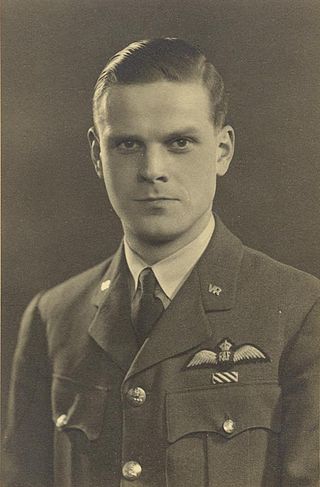
Wing Commander Peter Stanley James, was a pilot in the Royal Air Force Volunteer Reserve during the Second World War, flying in RAF Bomber Command with No. 35 Squadron, No. 78 Squadron and No. 148 Squadron.

The RAF bombing raid against the Schneider Works at Le Creusot, known as Operation Robinson, was undertaken during the daylight hours of 17 October 1942. The mission was assigned to No. 5 Group, which had converted to the new Avro Lancaster. The Lancaster’s large lift capacity and high speed gave reason for optimism that the raid might succeed.













